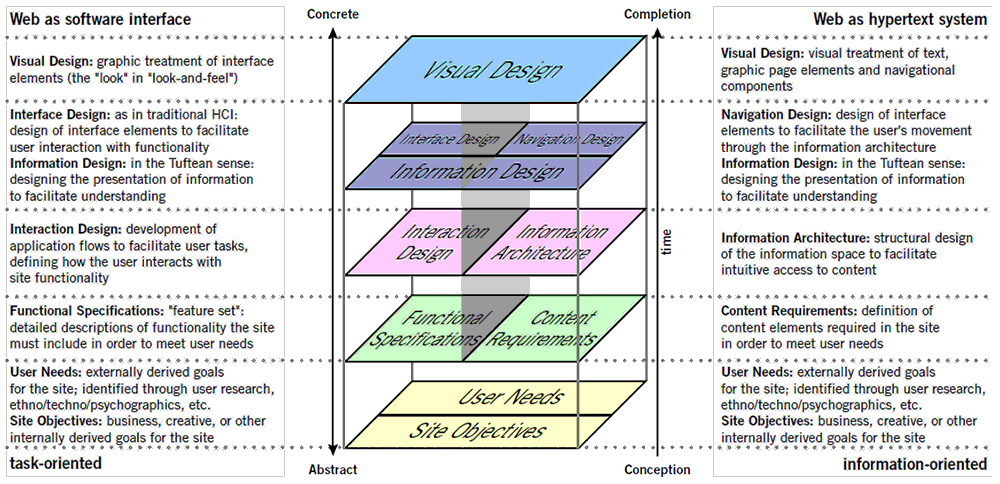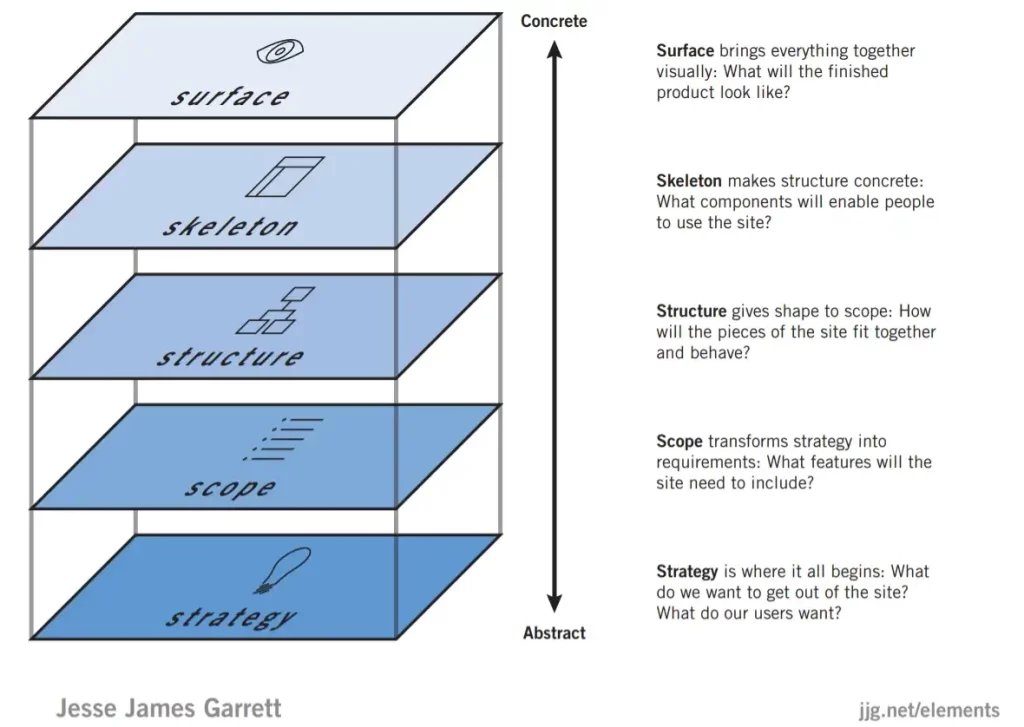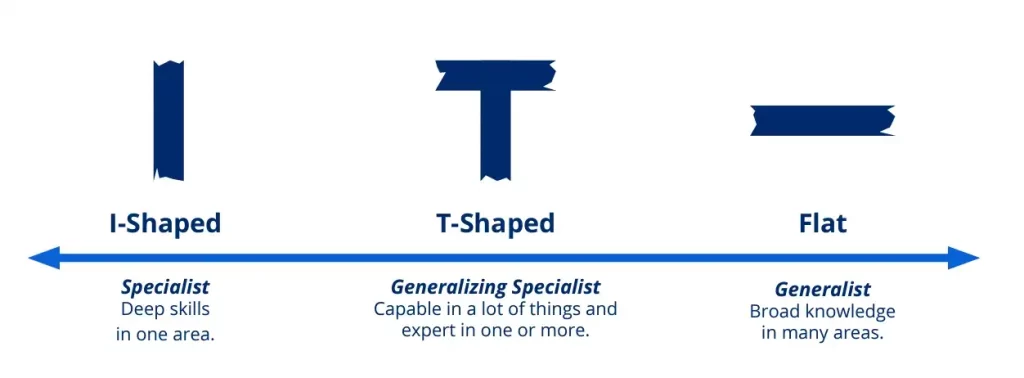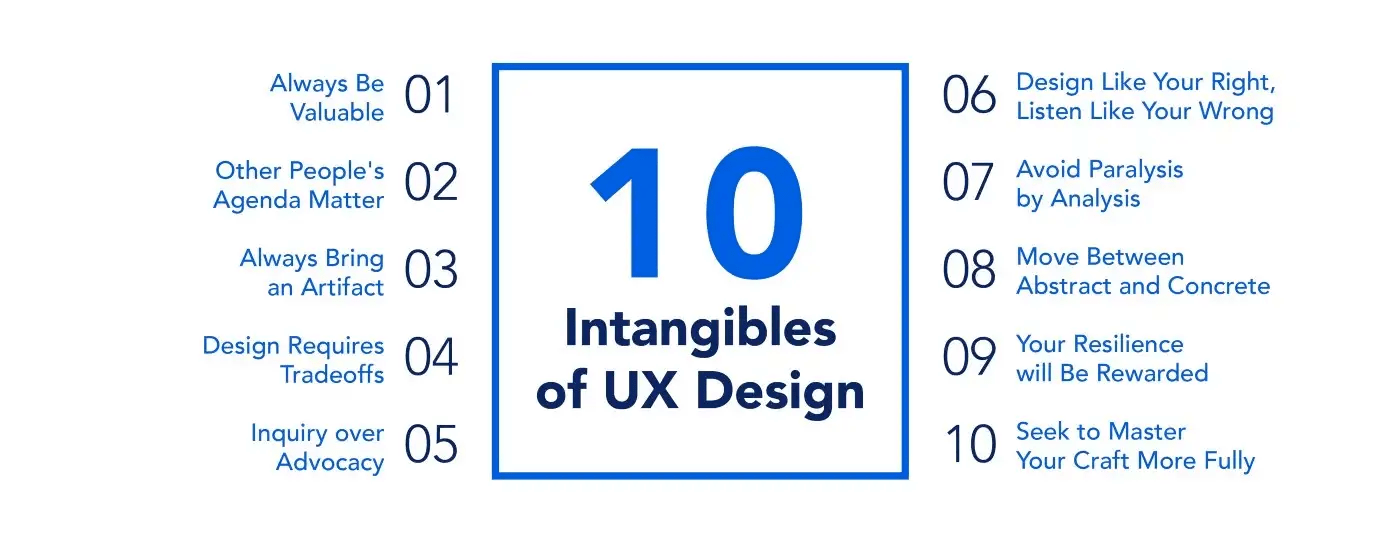Becoming and being a UX Designer involves multiple facets. Core Disciplines, Soft Skills, Leadership Skills, and Discipline-Specific Skills are all part of what it takes to be a great designer. But those aren’t enough. You can master Interaction Design, prototyping, facilitation skills, and empathy and still be lacking. In my 15+ years in the field, I have found that the difference between a decent, frustrated designer and a thriving designer is the presence of certain intangibles. These intangibles (sometimes I call them tenants) are not originally from me. Many of these were taught and drilled into my skull by a previous mentor, Davin Granroth. Others I picked up along the way. Shout out to John Parkinson for encouraging me to write these out and share them.
10 Intangibles of UX Design:
- Always Be Valuable
- Other People’s Agenda Matter
- Always Bring an Artifact
- Design Requires Tradeoffs
- Inquiry over Advocacy
- Design Like Your Right, Listen Like Your Wrong
- Avoid Paralysis by Analysis
- Move Between Abstract and Concrete
- Your Resilience Will Be Rewarded
- Seek to Master Your Craft More Fully
Always Be Valuable
Also known as “always be useful”. Being valuable can be divided up into 2 aspects; being valuable in solving problems for users and being valuable in serving those you work with.
User Experience is set apart from other professions by its ability to understand and solve problems for users. This goes beyond mastering your own disciplines and is bigger than any single artifact. As designers, you know how to be useful. First, seek to understand and define a problem, apply your skills and craft to solve that problem, and then ensure that the problem truly is solved for the benefit of others.
The usefulness of design is demonstrated in countless patterns, systems, and frameworks such as JJG’s Elements of UX, AIGA’s “Why Design”, Vignelli’s Intangibles, Morville’s Honeycomb and so many others. You know the shape and purpose of the work. Don’t get lost in passing fads, unethical design that elevates an organization at the cost of the user, or any other distraction.
Being valuable goes beyond serving the user. Serve those with whom you work, especially those who champion and advocate for users. Help them become more valuable. Show them that you can help them have success. And do it, repeatedly. Seek to apply your craft, perspective, insights, and methodology in building up others around you. This is about becoming a catalyst for work-culture change. A healthier work culture will ensure that user-centered design is valued and requested. Just be a valuable counselor to others. Over time, you will find satisfaction in seeing those you work with grow in wisdom, confidence, and competency for understanding and solving problems for others.
Other People’s Agenda Matter
It’s not always about you. Every person you work with has their own set of priorities and agenda related to the product, service, and interactions that designers are working on. Their agendas matter for several reasons:
First off, UX requires collaboration from many parts of an organization. Designers need developers, marketers, project managers, executives, and so many other people. You can’t do this work alone. If a designer only ever cares about their own agenda and acts as if they are God’s gift to an organization, good luck getting things done.
Second, you don’t know everything. A designer’s ideas aren’t the only good ones. Your agenda may not always be the best one. If a designer is humble enough to listen, they will learn some valuable things from the different perspectives around them. Some of my best work has come from listening to the priorities and agendas of others.
Third, over time you will gain advocates for your priorities. If you show genuine care for those people around you by helping colleagues advance their agendas, things will go well for you. Specifically, you will begin to see others advocate for your work.
Always Bring an Artifact
It never ceases to amaze me how terrible people are at communicating with one another. Two people can have a discussion about a topic, believe they are seeing things eye-to-eye, and walk away with very different interpretations of how the conversation went. This is devastating for designers! Designers are constantly having to understand business needs, constraints, and user needs through conversations over Slack, Zoom meetings, or face-to-face discussions. Having an artifact to use as a talking point is revolutionary.
Let me give you an example. Years ago I had a difficult time communicating the scope of design work with a colleague in Marketing. I was trying to explain that the problem with our support section went deeper than a single page or visual element. I was trying to tell her that the problem was in Information Architecture. The way in which we were categorizing and structuring the support articles was confusing and didn’t match the mental models of users. I was getting nowhere until I brought an artifact: Jesse James Garret’s Elements of UX. I explained that she was stuck at the Surface and Skeleton layers but the real problem was at the Structure layer. It changed everything. We finally communicated and the project moved forward toward IA work.

Always Bring an Artifact could mean bringing an exciting artifact like JJG’s Elements of UX, or it could mean bringing your own, like a mockup. Mockups, Interactions Flows, Service Blueprints, and the like are instrumental in communicating your ideas to the people you work with. Communicating your understanding of a problem and your approach to a solution is vital to design work.
Design Requires Tradeoffs
Designing and developing products and services is always about finding a balance. There’s balancing user needs and business goals. There’s balancing constraints and capabilities. Product Managers have to balance time, cost, and quality. There are finite resources all of which are being used to support a business. Designers need to understand this tension and embrace the push and pull. Most things are NOT mutually exclusive. Hold onto contradictions.
Practically speaking this means there is almost never a perfect solution to a problem or a perfect design. A designer could spend all the time in the world chasing the perfect design. But in the end, the design they come up with will end up having tradeoffs of some sort. Furthermore, the time spent to make a more perfect design itself is a tradeoff. In the time it took to do that near-perfect design, another designer could have shipped value to the user over, and over again, learning along the way how to improve the design.
Design must understand the tension they live in, embrace it and face it head-on. Designers must always understand what tradeoffs exist in the work they do as they move forward.
Inquiry over Advocacy
Seek first to understand rather than be understood. Listen to why someone sees things differently than you. This is critical in design work for several reasons.
The first is when interacting with and understanding users. Many well-meaning designers can get frustrated when users don’t behave the way they think they should. Designers can get defensive when users criticize their work. As a side note, this is a good time to suggest that you have another designer or researcher lead interviews, critiques, or usability tests for your design work. Users will react to your designs in an honest and visceral way. It isn’t personal. Seek to understand their perspective instead of defending your own.
The second is when working with colleagues. Designers, developers, marketers, managers, Product Managers, and anyone else you work with all have different ways of looking at things. These people have different life experiences, different professional backgrounds, and different skills. Say you are having a discussion about the scope of work or tradeoffs or whatever it is, seek first to understand their point of view before trying to get them to understand yours. You may learn something that helps you in your quest to solve problems for people and you may gain an ally along the way.
Final thought: This is NOT “Inquiry instead of Advocacy”. As a designer, your job is to understand and solve problems. You need to do that with confidence and conviction. I am not suggesting that designers become “Yes, people” who simply go along with every else’s ideas and direction. Show humility by acknowledging that other people’s perspective matters. Show wisdom by listening to other people that may know more than you. Show respect by not bullying others by simply pushing your understanding on them.
Design Like Your Right, Listen Like Your Wrong
Ok, so a designer has gone through their process of understanding a problem space, defining the problems, and conceptualizing potential solutions. Next, they are ready to move forward in a particular direction. Great! They should have a high level of confidence in that direction. “Design like your right” isn’t a puffed-up arrogance but a confidence that comes from being well-informed as a result of doing your due diligence. It is not manufactured but a natural outcome. Designers should feel the freedom to move forward with conviction and stand by their design decisions. But it doesn’t stop there.
Though a designer ought to feel a sense of confidence and conviction in their work, they also need to be humble enough to listen to feedback that challenges it. This most often comes through large releases when a high volume of users begins to interact with a designer’s work. Designers need to shift towards humbly listening to feedback from users. Don’t be defensive, don’t take it personally. Listen like you’re wrong as if may have been working with missing information. You can’t replicate real-work usage through prototypes and usability tests. You won’t know you are wrong until you’ve already moved forward.
Avoid Paralysis by Analysis
In our quest to understand, define, and solve problems, designers can become bombarded with information. Qualitative and Quantitative Data, User Needs, Business Goals, Constraints, Trade-Offs, AGHGG! It can be a lot to sift through. The data is meant to inform, not to paralyze you. Anytime I am feeling like I’m overwhelmed and drowning in a sea of data, I remind myself “There is no perfect design”. Take a shot and move forward.
It is better to move forward with something partially good than to not move forward at all.
Move Between Abstract and Concrete
I’m dipping back into the Jesse James Garrett pool for this one. Seriously, if you haven’t read his book Elements of User Experience, then go buy it now and read it.
JJG imagines UX as a continuum. Design is shown to be expressed through 5 layers that move from Abstract (like Strategy) and Concrete (like Surface). Designers have to understand and be comfortable moving and working through these layers. A UX designer cannot be a UI designer alone, nor can they be an Information Architect alone. UX designers need to be able to move between the Abstract and Concrete.

UX Designers are able to move between the Abstract and Concrete by being T-Shaped professionals. A T-shaped person is capable in many different disciplines and expert in, at least, one discipline. As opposed to an I-shaped person who is an expert in one thing or a generalist who has broad knowledge in many areas but is not an expert in any. An alternate phrase for “T-Shaped” is “Generalizing Specialist”. UX is a T-Shaped field of study. Therefore, UX professionals ought to be T-Shaped or a Generalizing Specialist.

In short, designers need to be multi-disciplined and have a baseline understanding of all of the Core Disciplines of UX. Once a designer knows these disciplines, they must be able to move from the Abstract disciplines, into the Concrete disciplines, and everything in between.
Your Resilience Will Be Rewarded
The field of design can be soul-crushing. All this problem-solving and finding balance and fighting battles and hitting obstacles can wear you down. In the presence of pain, we must keep pursuing excellence.
Resiliency is the ability to recover from or adjust easily to adversity or change; the capacity to adapt to stressful circumstances and to bounce back from adverse events.
Many of the tenets shared in this article can help a designer become more resilient but I’d like to share a few more tips:
- Nothing lasts forever. No matter how things are for you on a project or at an organization, things will get better. Either the situation will improve or your ability to navigate it will.
- You can’t reap the benefits if you give up. The work we do as designers matters. If we can stick it out through the difficult times, we may get to see the outcome of our efforts. If you give up, you will never see what could’ve been.
- Your time is not wasted even if the outcome isn’t what you thought it would be. Your time and effort mean something. You can learn and grow even from failures, misses, and mistakes.
- Remember your work doesn’t define who you are. Your successes and failures and your job do not make you who you are. You are more than your job as a designer.
Resiliency doesn’t mean putting up with abusive situations or that you stick it out through every terrible project. But it does challenge our instinct to give up when things get tough. Being a designer is one of the hardest professions but it is also one of the most rewarding and impactful professions. Be resilient and you will be shocked at the outcome.
Seek to Master Your Work More Fully
Understanding and mastering UX Design is a lifelong endeavor. You have never reached the end. You will never have learned all there is to know. This isn’t so much about learning new disciplines, though that may be part of your need, this is about understanding what you know and finding ways to apply it in more impactful ways. Most of this article has been about applying what you know in a fresh way. We’re not discussing new tools or wire-framing techniques, or research methods. This article is about understanding what you know and where you are and reframing it to have a greater impact.
A mentor of mine, Davin, said this about mastering your craft:
it is easy to learn the alphabet, it is easy to learn new words, it is easy to learn patterns of language. These things are simple. But communicating well is exceedingly complex, because purpose, people, empathy, and context all shift and flow. The elements and rules of communication are simple but communicating well is a question of mastery. We are, [designers] in essence, communicators, and we can always achieve more profound mastery through the deeper study of simple fundamentals. That said, there are days when I, after years of work, consider what I think I know, and then I get an inkling of how much I don’t know. There are so many questions, so many unknowns, so much that we could do so much better. So, please, keep at it. Study your craft in many ways for your whole life. The world needs mastery.
Never stop learning, and never stop pursuing to master your craft. Read articles, challenge your thinking, listen to others, and do whatever it takes to continue to grow.








